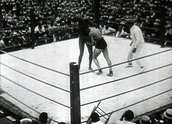
Boxing 1908: Johnson vs Burns (1908)
Synopsis
Historical footage of an open-air boxing match held at Sydney Stadium, Rushcutters Bay, on 26 December 1908. Canadian Tommy Burns and African American Jack Johnson are competing for the World Heavyweight Championship title. Fight promoter Hugh McIntosh referees the match. The footage shows some of the middle rounds of the 14-round fight.
Curator’s notes
Only fragments survive of this legendary match, in which Jack Johnson defeated Tommy Burns in front of a 20,000 strong crowd at Rushcutters Bay, but what remains is utterly engrossing. The tall, lean African-American Johnson had followed Burns around the boxing circuit urging Burns to fight him for the title in the ring. The Boxing Day match drew an unprecedented crowd and went for 14 rounds, ending with Johnson becoming the first black man to win the World Heavyweight Championship title.
Johnson was a theatrical fighter and he can be seen in this footage regularly flashing a smile or holding a proud pose to the crowd to taunt and unsettle his opponent. Ten days earlier, Johnson was filmed in training at Rushcutters Bay (Training at Rushcutters Bay, 1908) where he performed for the camera in front of a smaller, more intimate crowd.
Photographic records of the Boxing Day event show that the camera operators filmed the fight from an elevated platform situated diagonally to the ring on Burns’s side. Local fight promoter and referee Hugh McIntosh reportedly toured the film around Europe and America. Pioneer Australian director Raymond Longford is also known to have made a feature-length documentary of the fight (The Burns-Johnson Fight, 1908) with Ernest Higgins as cinematographer. What’s not clear is whether they shared the footage with McIntosh or if there were two separate productions and, if separate, whether the footage shown here is McIntosh’s or Longford’s. McIntosh may have hired Spencers Pictures (for which Longford and Higgins both worked) to film the bout. However, since any camera recording the event would have filmed from the same platform, there would be no real difference in the footage from the two cameras in any case.
The surviving highlights provide a glimpse into the biggest sporting event staged at the time and, even if you’re not a boxing fan, it is great to watch. Most of the action in Boxing 1908: Johnson vs Burns is shot with the boxing ring taking up most of the frame. Seated spectators (all male) in the front few rows are visible behind the scorers and match officials, all of whom eagerly look on. Still photographers can be seen on the ring’s edges regularly taking snaps as the players move around. The camera remains steady throughout but follows the action by panning slightly with the movement. At the end of each round, a man can be seen holding up a large numbered card to the crowd, to indicate the coming round. This footage cuts out before the final round, but reports say that police stopped the fight and prevented the cameras from rolling when Johnson knocked Burns out.
- Overview
- Curator’s notes
- Video 1 clip
- Find a copy
- Comments 1
- Map
- Add your review



